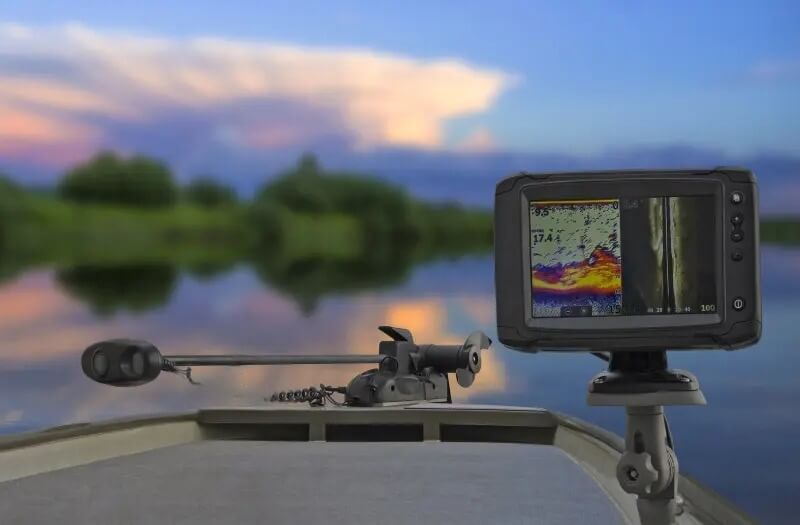Hello Everyone, If you’re a passionate angler or a boating enthusiast looking to up your fishing game, you’ve probably heard about fish finders. These nifty devices have become indispensable tools for locating fish beneath the water’s surface, but do fish finders come with transducers?
In this comprehensive guide, we will explore the crucial role of transducers in fish finders, why they are essential, and what you should know before choosing the right one for your fishing adventures.
Understanding Transducers:
Transducers are the unsung heroes of fish finders. They are the key components responsible for sending and receiving sonar signals that provide critical information about what lies beneath the water.
Essentially, transducers work like underwater eyes, emitting sound waves (sonar) and interpreting the echoes to create detailed images of the underwater environment.
Best Fish Finder To Buy:- Simrad Fish Finder Review
Why Transducers Are Essential:
- Fish Detection: Transducers are essential for detecting fish. When the sonar signals bounce off fish or other underwater objects, the transducer receives the echoes and displays them on your fish finder’s screen. This helps you identify the size, depth, and location of fish, significantly increasing your chances of a successful catch.
- Depth Measurement: Transducers play a vital role in measuring water depth accurately. They send sound waves downward until they reach the seafloor, and the time it takes for the echoes to return helps calculate the water’s depth. This information is crucial for safe navigation and successful fishing.
- Mapping Underwater Structures: Whether you’re looking for underwater structures like rocks, reefs, or shipwrecks, transducers provide detailed images that help you navigate safely and find ideal fishing spots. Understanding the underwater terrain can be the difference between a successful trip and disappointment.
Types of Transducers:
Fish finders typically come with two types of transducers: single-frequency and dual-frequency. Single-frequency transducers are excellent for shallow waters, while dual-frequency transducers are versatile and suitable for both shallow and deep waters. Choosing the right transducer depends on your fishing preferences and the environments you frequent.
How do fish finders work?
Have you ever wondered how those savvy anglers seem to effortlessly locate fish beneath the water’s surface? The secret behind their success lies in a remarkable piece of technology known as the fish finder. In this user-friendly guide, we’ll dive deep into the fascinating world of fish finders, uncovering how they work, and demystifying their inner workings.
1. Sonar Technology: The Underwater Soundwaves
At the heart of every fish finder is sonar technology, which stands for “Sound Navigation and Ranging.” It operates on a simple yet incredibly effective principle: sending sound waves into the water and listening for their echoes. Here’s how it works:
- Signal Emission: The fish finder’s transducer, typically mounted on the boat’s hull, sends out a cone-shaped beam of high-frequency sound waves into the water below. These sound waves travel through the water until they encounter an object in their path.
- Echo Reception: When the sound waves hit an object—whether it’s a fish, a rock, or the seafloor—they bounce back as echoes. The transducer immediately picks up these echoes and sends the information back to the fish finder’s display unit.
2. Interpreting the Echoes: Creating a Visual Display
Once the fish finder receives the echoes, it’s time to turn them into a meaningful visual display. This is where the magic happens:
- Echo Processing: The fish finder’s internal processor interprets the time it takes for the echoes to return and their intensity. This information is then transformed into detailed images displayed on your screen.
- The Display: On the screen, you’ll see a graphical representation of what’s beneath your boat. Fish are depicted as arches or dots, and the seafloor and underwater structures are displayed as lines or contours. By analyzing these images, you can identify fish, measure water depth, and even locate underwater structures.
3. Understanding the Data: Making Informed Decisions
Now that you have this wealth of information at your disposal, it’s time to put it to good use:
- Fish Detection: By identifying fish echoes on the screen, you can pinpoint the fish’s location, depth, and sometimes even their size. This invaluable information allows you to target specific areas where fish are most active, increasing your chances of a successful catch.
- Water Depth: Knowing the exact water depth is crucial for safe navigation and finding the right fishing spots. Fish finders provide real-time depth measurements, ensuring you avoid shallow areas and underwater obstacles.
- Mapping Underwater Terrain: Fish finders also help you map the underwater terrain, such as rocks, reefs, and drop-offs. This knowledge is essential for avoiding hazards and finding ideal fishing locations.
In summary, fish finders are remarkable devices that leverage sonar technology to unveil underwater mysteries and give you an edge in the world of fishing. They work by emitting sound waves, receiving echoes, and translating this data into visual displays.
With the information provided by your fish finder, you can make informed decisions about where to cast your line, ensuring a more productive and enjoyable fishing experience. So, next time you’re out on the water, remember that beneath the surface, your trusty fish finder is hard at work, helping you uncover the aquatic world’s secrets.
How do transducers work?
Transducers are the unsung heroes of underwater exploration, serving as the eyes and ears of various marine technologies, including fish finders and depth sounders. In this user-friendly guide, we’ll demystify the fascinating world of transducers, explaining how these devices work to provide us with invaluable insights into what lies beneath the water’s surface.
At its core, a transducer operates on the principle of sending and receiving sound waves, a technology known as sonar (Sound Navigation and Ranging). Here’s a simplified breakdown of how transducers work:
1. Sound Wave Emission: The transducer emits a focused beam of high-frequency sound waves into the water below. These sound waves travel through the water in a cone-shaped pattern until they encounter an object in their path, be it a fish, a submerged structure, or the seafloor.
2. Echo Reception: When the emitted sound waves hit an object, they bounce back as echoes. The transducer immediately senses these echoes, capturing the returning sound waves.
3. Time and Intensity Analysis: The transducer’s internal processor then analyzes the time it takes for the echoes to return and their intensity. This information provides crucial data about the object’s distance, size, and composition.
4. Data Visualization: The processed data is translated into visual representations on the connected device’s screen. For fish finders, this often results in fish arches or dots, while depth sounders display real-time water depth measurements.
5. Real-Time Feedback: This real-time feedback allows boaters, anglers, and marine enthusiasts to make informed decisions based on the underwater information provided by the transducer. Whether it’s avoiding shallow areas, pinpointing fish, or mapping underwater structures, transducers empower users with a deeper understanding of the aquatic environment.
In summary, transducers are the key to unlocking underwater visibility, enabling us to explore and navigate the aquatic world with confidence. By emitting sound waves, capturing echoes, and processing the data, these remarkable devices offer a window into the mysteries of what lies beneath the water’s surface, enhancing safety, navigation, and the art of fishing. So, next time you cast your line or navigate your boat, remember that it’s your trusty transducer that’s working silently beneath the waves, helping you see and understand the hidden world beneath.
Do fish finders come with transducers?

If you’re venturing into the world of fishing or boating, understanding the relationship between fish finders and transducers is crucial. To answer the question plainly: yes, fish finders typically come with transducers, and this pairing is essential for unlocking the underwater world. Let’s delve into this user-friendly explanation to demystify their collaboration.
Fish Finders: The Visualizers of the Deep
Fish finders are ingenious devices designed to help anglers and boaters see beneath the water’s surface. They achieve this through sonar technology, which involves emitting sound waves into the water and receiving their echoes. However, fish finders alone can’t do this—they rely on transducers to work their magic.
Transducers: The Sonic Communicators
Transducers are the unsung heroes that make it all possible. These small yet powerful devices are responsible for sending out the sound waves (sonar signals) and listening for their return. Mounted on the boat’s hull, transducers convert electrical energy into sound waves and vice versa.
When the sound waves hit underwater objects, they bounce back as echoes, which the transducer detects and sends to the fish finder. In turn, the fish finder processes this information and displays it as visual data on your screen.
This visual data allows you to see fish, underwater structures, and water depth, ultimately helping you make informed decisions for a successful and enjoyable fishing or boating experience. So, in essence, fish finders and transducers are inseparable partners, working together to unveil the secrets hidden beneath the water’s surface and enhancing your underwater exploration.
Must Read:-
- How to Read Fish Finder Garmin?
- Is a fish finder worth it?
- How To Use A Fish Finder?
- Benefits of choosing Fish Finders in 2023
Conclusion:
In conclusion, fish finders do indeed come with transducers, and these components are integral to the device’s functionality. Transducers enable you to detect fish, measure water depth accurately, and map underwater structures, all of which are essential for a successful and safe fishing experience.
When choosing a fish finder, consider the type of transducer it comes with and ensure it suits your fishing needs. With the right fish finder and transducer combination, you can take your fishing adventures to the next level and explore the underwater world with confidence.





